2013 TOYOTA YARIS HATCHBACK load capacity
[x] Cancel search: load capacityPage 260 of 403
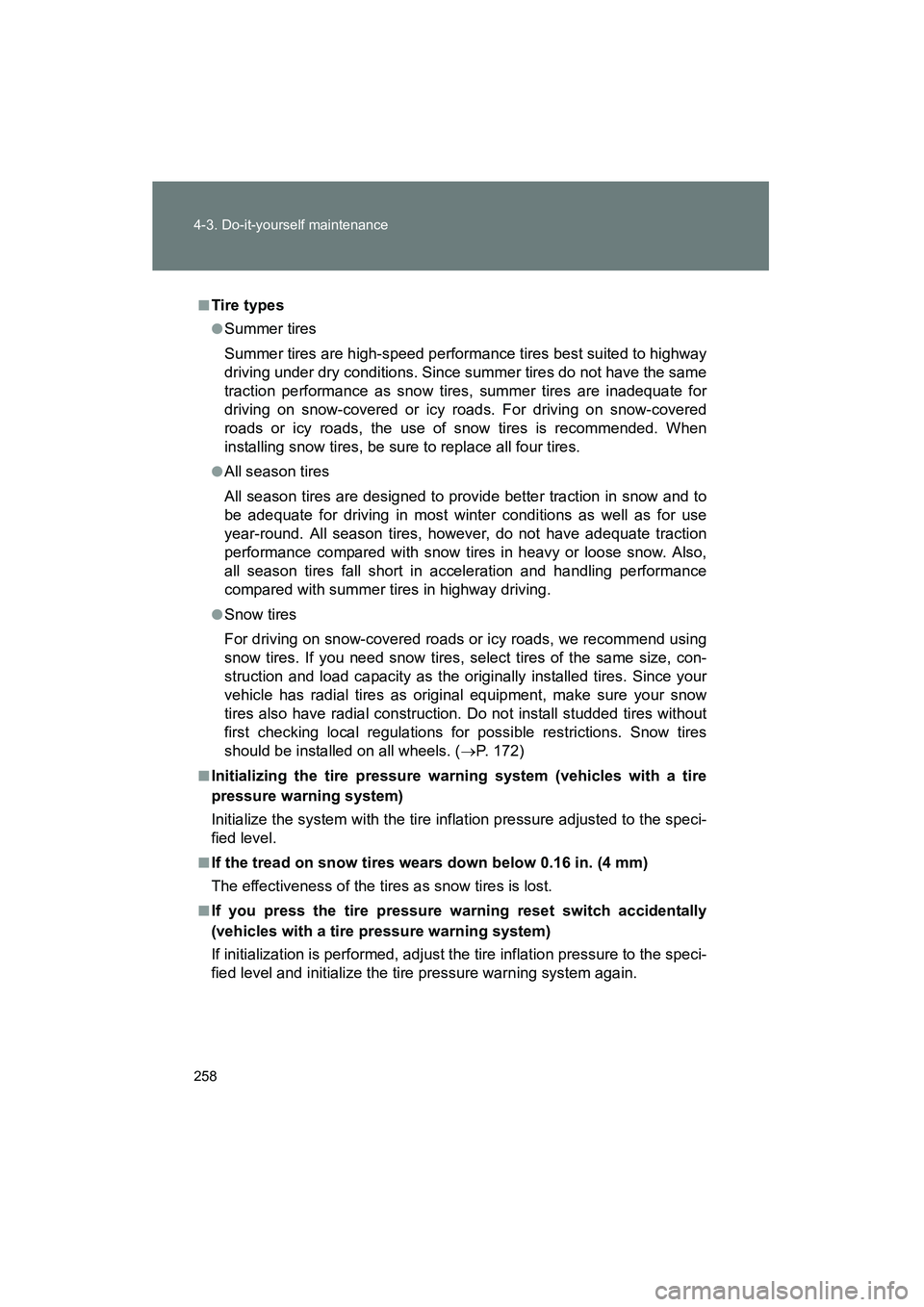
258 4-3. Do-it-yourself maintenance
YARIS_HB_U_52D44U
■Tire types
●Summer tires
Summer tires are high-speed performance tires best suited to highway
driving under dry conditions. Since summer tires do not have the same
traction performance as snow tires, summer tires are inadequate for
driving on snow-covered or icy roads. For driving on snow-covered
roads or icy roads, the use of snow tires is recommended. When
installing snow tires, be sure to replace all four tires.
●All season tires
All season tires are designed to provide better traction in snow and to
be adequate for driving in most winter conditions as well as for use
year-round. All season tires, however, do not have adequate traction
performance compared with snow tires in heavy or loose snow. Also,
all season tires fall short in acceleration and handling performance
compared with summer tires in highway driving.
●Snow tires
For driving on snow-covered roads or icy roads, we recommend using
snow tires. If you need snow tires, select tires of the same size, con-
struction and load capacity as the originally installed tires. Since your
vehicle has radial tires as original equipment, make sure your snow
tires also have radial construction. Do not install studded tires without
first checking local regulations for possible restrictions. Snow tires
should be installed on all wheels. (→P. 172)
■Initializing the tire pressure warning system (vehicles with a tire
pressure warning system)
Initialize the system with the tire inflation pressure adjusted to the speci-
fied level.
■If the tread on snow tires wears down below 0.16 in. (4 mm)
The effectiveness of the tires as snow tires is lost.
■If you press the tire pressure warning reset switch accidentally
(vehicles with a tire pressure warning system)
If initialization is performed, adjust the tire inflation pressure to the speci-
fied level and initialize the tire pressure warning system again.
Page 268 of 403
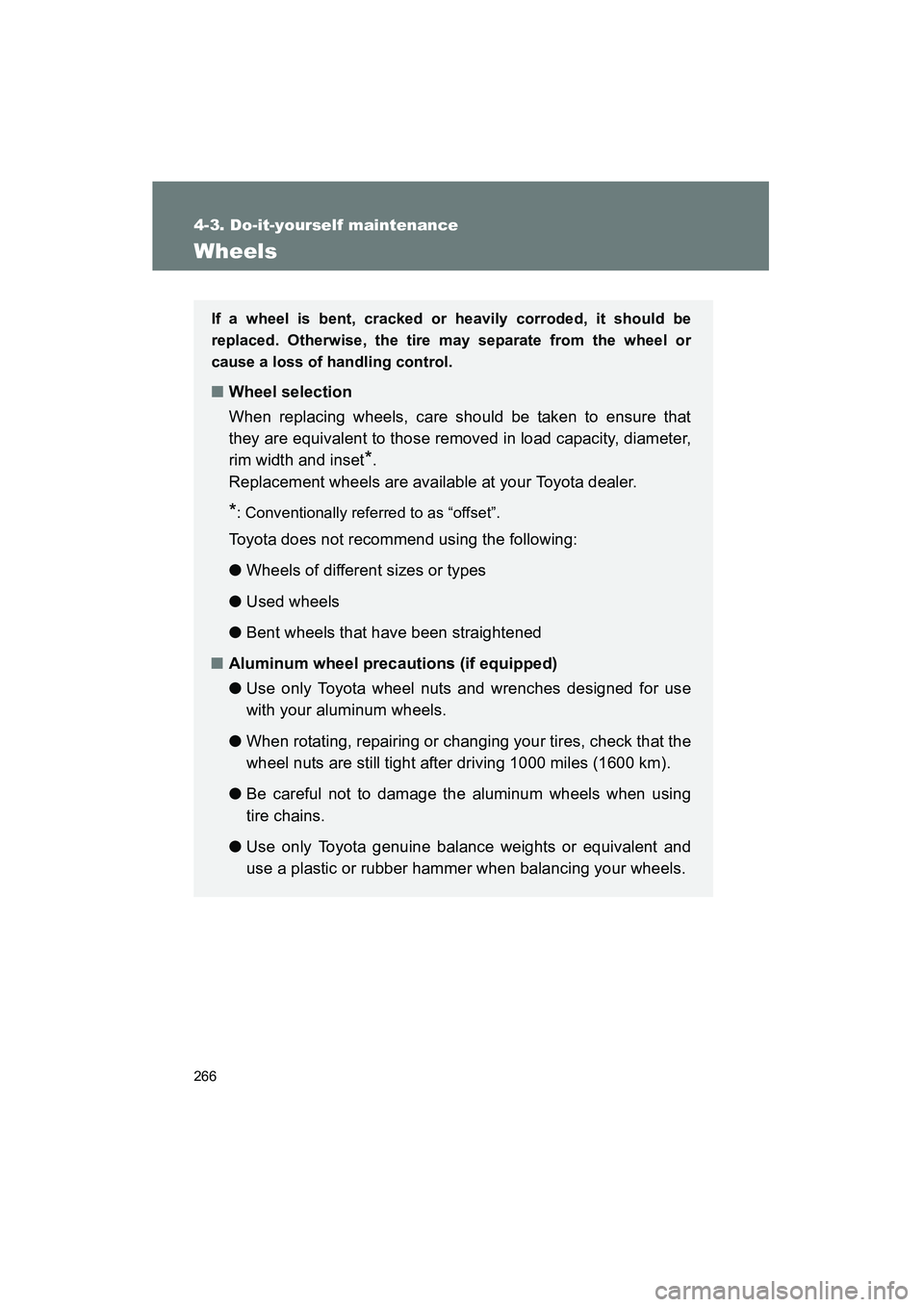
266
4-3. Do-it-yourself maintenance
YARIS_HB_U_52D44U
Wheels
If a wheel is bent, cracked or heavily corroded, it should be
replaced. Otherwise, the tire may separate from the wheel or
cause a loss of handling control.
■Wheel selection
When replacing wheels, care should be taken to ensure that
they are equivalent to those removed in load capacity, diameter,
rim width and inset
*.
Replacement wheels are available at your Toyota dealer.
*: Conventionally referred to as “offset”.
Toyota does not recommend using the following:
● Wheels of different sizes or types
● Used wheels
● Bent wheels that have been straightened
■ Aluminum wheel precautions (if equipped)
●Use only Toyota wheel nuts and wrenches designed for use
with your aluminum wheels.
● When rotating, repairing or changing your tires, check that the
wheel nuts are still tight after driving 1000 miles (1600 km).
● Be careful not to damage the aluminum wheels when using
tire chains.
● Use only Toyota genuine balance weights or equivalent and
use a plastic or rubber hammer when balancing your wheels.
Page 349 of 403

347
6-1. Specifications
6
Vehicle specifications
YARIS_HB_U_52D44U
Oil viscosity (5W-30 is explained here as an example):
●
The 5W in 5W-30 indicates the characteristic of the oil which allows
cold startability. Oils with a lower value before the W allow for easier
starting of the engine in cold weather.
● The 30 in 5W-30 indicates the viscosity characteristic of the oil when
the oil is at high temperature. An oil with a higher viscosity (one with a
higher value) may be better suited if the vehicle is operated at high
speeds, or under extreme load conditions.
How to read oil container label:
The ILSAC (International Lubricant Standardization and Approval
Committee) Certification Mark is added to some oil containers to help
you select the oil you should use.
Cooling system
Capacity
(Reference) Vehicles with an automatic transmission:
4.9 qt. (4.6 L, 4.0 Imp.qt.)
Vehicles with a manual transmission:
5.0 qt. (4.7 L, 4.1 Imp.qt.)
Coolant typeUse either of the following:
• “Toyota Super Long Life Coolant”
• A similar high-quality ethylene glycol-based non-silicate, non-amine, non-nitrite,
and non-borate coolant with long-life
hybrid organic acid technology
Do not use plain water alone.
Page 364 of 403
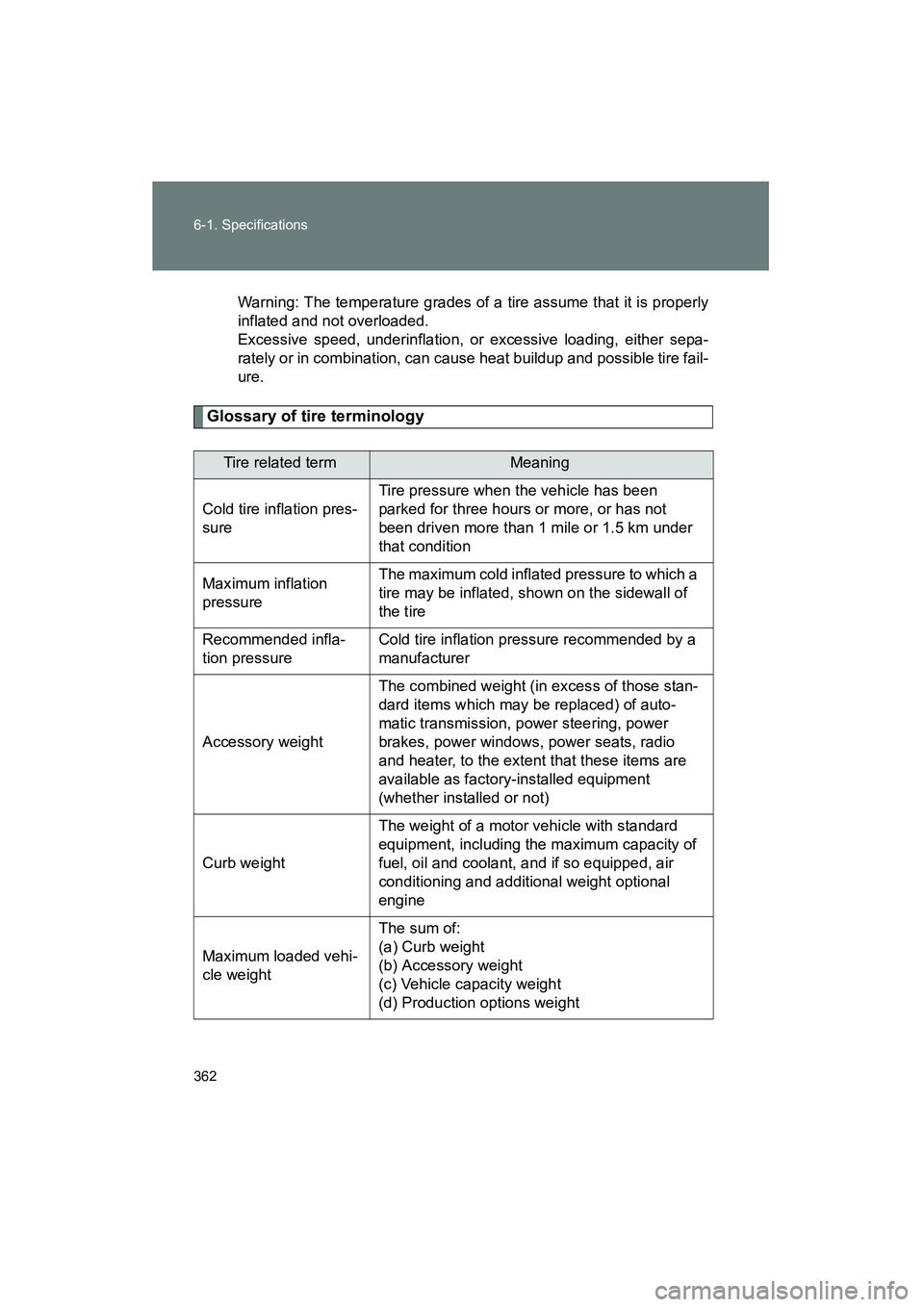
362 6-1. Specifications
YARIS_HB_U_52D44U
Warning: The temperature grades of a tire assume that it is properly
inflated and not overloaded.
Excessive speed, underinflation, or excessive loading, either sepa-
rately or in combination, can cause heat buildup and possible tire fail-
ure.
Glossary of tire terminology
Tire related termMeaning
Cold tire inflation pres-
sure
Tire pressure when the vehicle has been
parked for three hours or more, or has not
been driven more than 1 mile or 1.5 km under
that condition
Maximum inflation
pressureThe maximum cold inflated pressure to which a
tire may be inflated, shown on the sidewall of
the tire
Recommended infla-
tion pressureCold tire inflation pressure recommended by a
manufacturer
Accessory weight
The combined weight (in excess of those stan-
dard items which may be replaced) of auto-
matic transmission, power steering, power
brakes, power windows, power seats, radio
and heater, to the extent that these items are
available as factory-installed equipment
(whether installed or not)
Curb weight
The weight of a motor vehicle with standard
equipment, including the maximum capacity of
fuel, oil and coolant, and if so equipped, air
conditioning and additional weight optional
engine
Maximum loaded vehi-
cle weight
The sum of:
(a) Curb weight
(b) Accessory weight
(c) Vehicle capacity weight
(d) Production options weight
Page 365 of 403
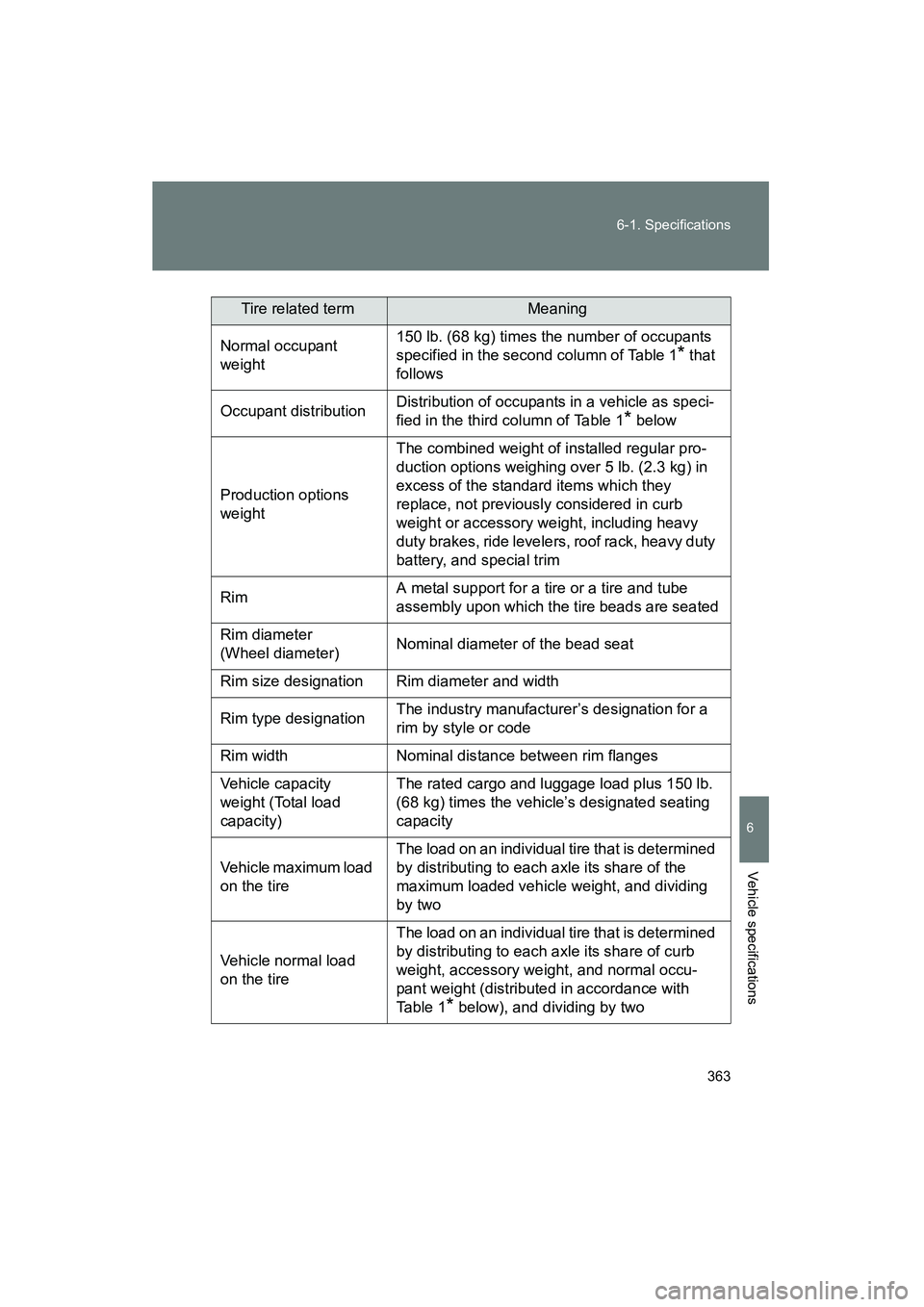
363
6-1. Specifications
6
Vehicle specifications
YARIS_HB_U_52D44U
Normal occupant
weight150 lb. (68 kg) times the number of occupants
specified in the second column of Table 1
* that
follows
Occupant distributionDistribution of occupants in a vehicle as speci-
fied in the third column of Table 1
* below
Production options
weight
The combined weight of installed regular pro-
duction options weighing over 5 lb. (2.3 kg) in
excess of the standard items which they
replace, not previously considered in curb
weight or accessory weight, including heavy
duty brakes, ride levelers, roof rack, heavy duty
battery, and special trim
RimA metal support for a tire or a tire and tube
assembly upon which the tire beads are seated
Rim diameter
(Wheel diameter)Nominal diameter of the bead seat
Rim size designationRim diameter and width
Rim type designationThe industry manufacturer’s designation for a
rim by style or code
Rim widthNominal distance between rim flanges
Vehicle capacity
weight (Total load
capacity)The rated cargo and luggage load plus 150 lb.
(68 kg) times the vehicle’s designated seating
capacity
Vehicle maximum load
on the tire
The load on an individual tire that is determined
by distributing to each axle its share of the
maximum loaded vehicle weight, and dividing
by two
Vehicle normal load
on the tire
The load on an individual tire that is determined
by distributing to each axle its share of curb
weight, accessory weight, and normal occu-
pant weight (distributed in accordance with
Table 1
* below), and dividing by two
Tire related termMeaning
Page 369 of 403
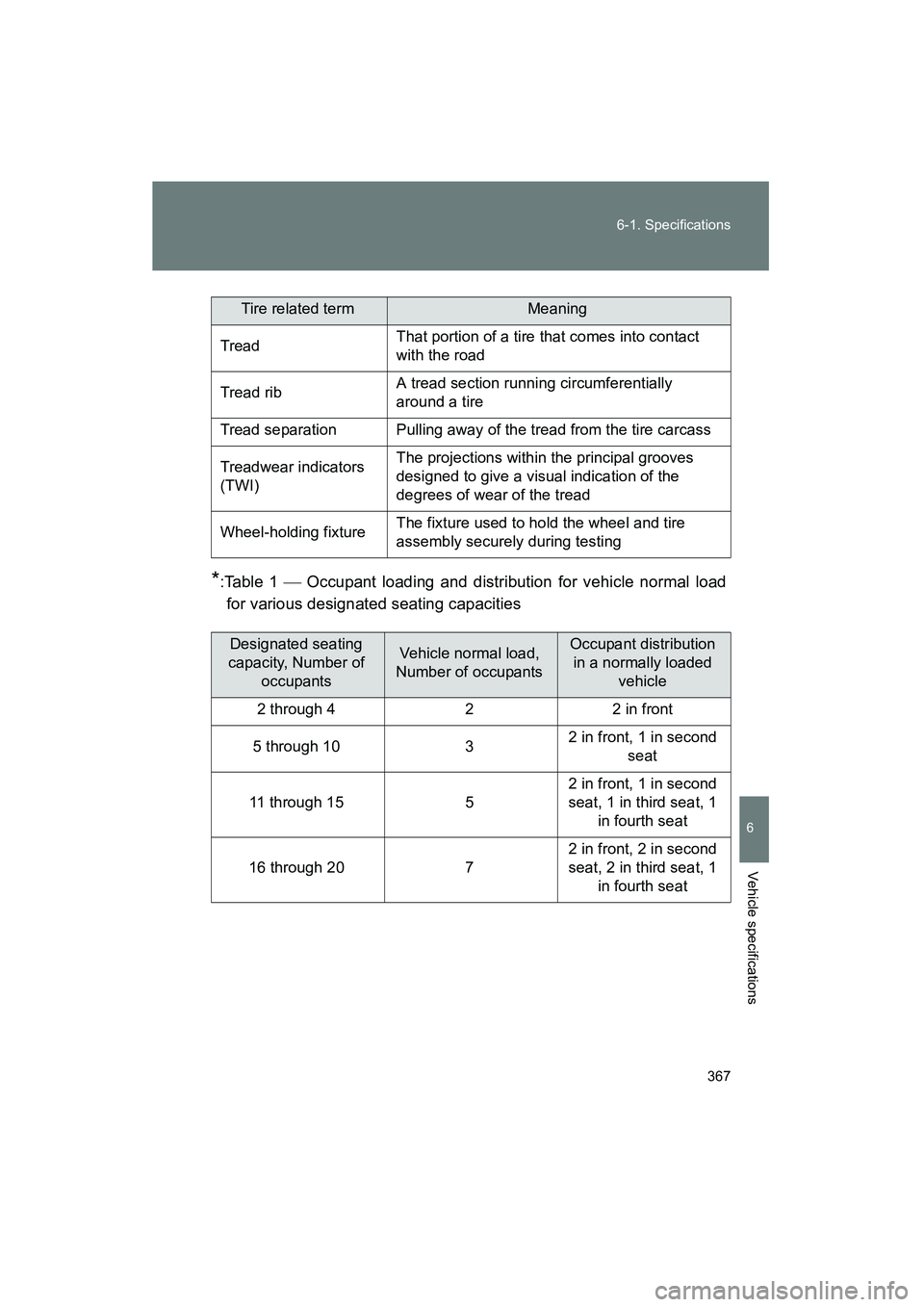
367
6-1. Specifications
6
Vehicle specifications
YARIS_HB_U_52D44U
*:Table 1
Occupant loading and distribution for vehicle normal load
for various designated seating capacities
TreadThat portion of a tire that comes into contact
with the road
Tread ribA tread section running circumferentially
around a tire
Tread separationPulling away of the tread from the tire carcass
Treadwear indicators
(TWI)The projections within the principal grooves
designed to give a visual indication of the
degrees of wear of the tread
Wheel-holding fixtureThe fixture used to hold the wheel and tire
assembly securely during testing
Designated seating
capacity, Number of occupants Vehicle normal load,
Number of occupantsOccupant distribution in a normally loaded vehicle
2 through 422 in front
5 through 1032 in front, 1 in second seat
11 through 155
2 in front, 1 in second
seat, 1 in third seat, 1 in fourth seat
16 through 207
2 in front, 2 in second
seat, 2 in third seat, 1 in fourth seat
Tire related termMeaning
Page 393 of 403
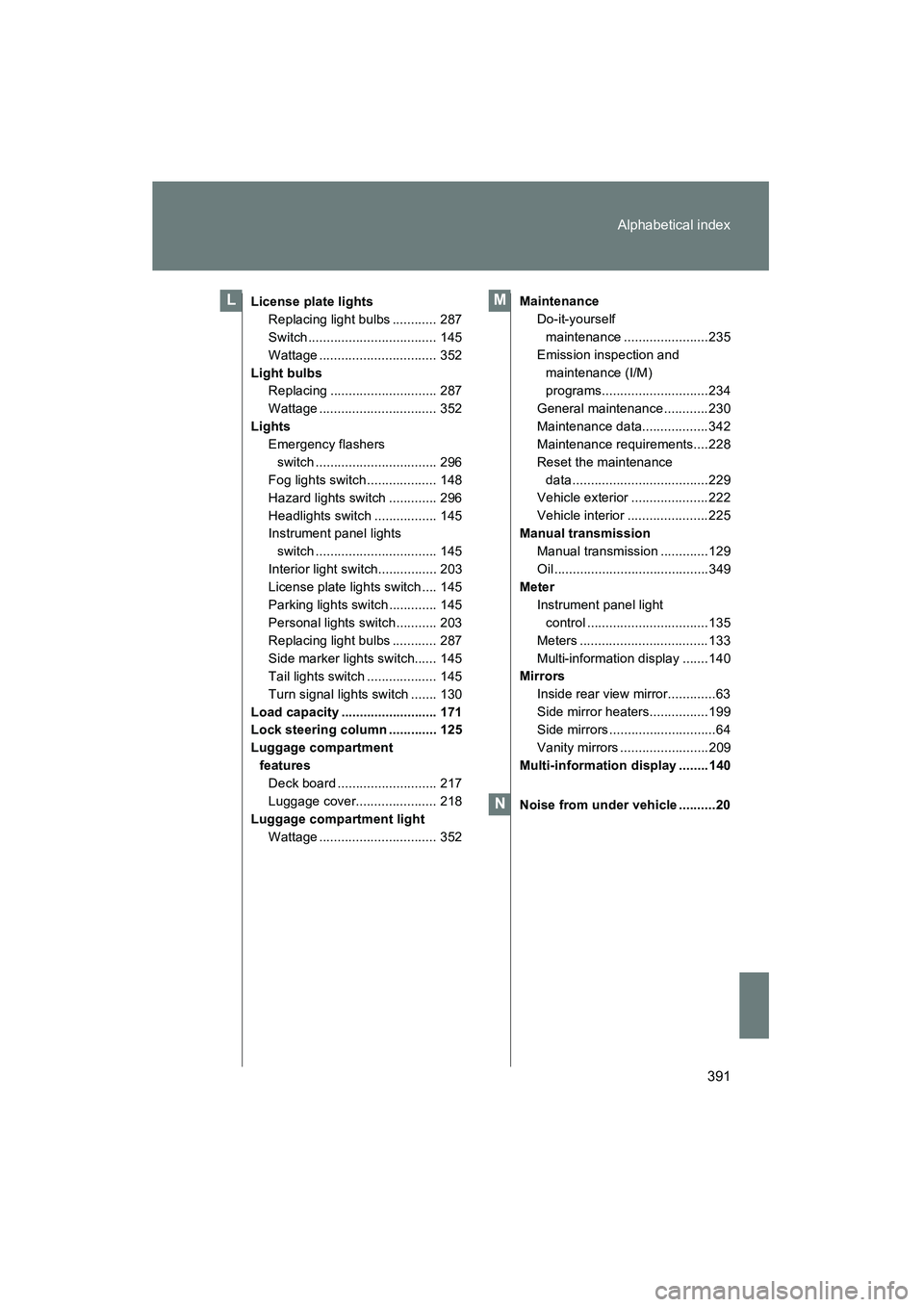
391
Alphabetical index
YARIS_HB_U_52D44U
License plate lights
Replacing light bulbs ............ 287
Switch ................................... 145
Wattage ................................ 352
Light bulbs Replacing ............................. 287
Wattage ................................ 352
Lights Emergency flashers switch ................................. 296
Fog lights switch ................... 148
Hazard lights switch ............. 296
Headlights switch ................. 145
Instrument panel lights switch ................................. 145
Interior light switch................ 203
License plate lights switch .... 145
Parking lights switch ............. 145
Personal lights switch ........... 203
Replacing light bulbs ............ 287
Side marker lights switch...... 145
Tail lights switch ................... 145
Turn signal lights switch ....... 130
Load capacity .......................... 171
Lock steering column ............. 125
Luggage compartment features Deck board ........................... 217
Luggage cover...................... 218
Luggage compartment light Wattage ................................ 352 Maintenance
Do-it-yourself maintenance .......................235
Emission inspection and maintenance (I/M)
programs.............................234
General maintenance ............ 230
Maintenance data.................. 342
Maintenance requirements....228
Reset the maintenance data .....................................229
Vehicle exterior ..................... 222
Vehicle interior ...................... 225
Manual transmission Manual transmission .............129
Oil ..........................................349
Meter Instrument panel light
control .................................135
Meters ................................... 133
Multi-information display .......140
Mirrors Inside rear view mirror.............63
Side mirror heaters................199
Side mirrors .............................64
Vanity mirrors ........................209
Multi-information display ........140
Noise from under vehicle ..........20LM
N
Page 396 of 403

394 Alphabetical index
YARIS_HB_U_52D44U
TiresChains ...................................172
Checking ............................... 254
If you have a flat tire..............315
Identification number .............356
Inflation pressure...........262, 351
Inflation pressure sensor .......255
Information ............................ 356
Replacing ......................254, 315
Rotating tires .........................254
Size .......................................351
Snow tires .............................172
Spare tire............................... 315
Tire pressure warning system ........................255, 307
Warning light .........................307
Tools ......................................... 315
Total load capacity...................171
Towing Dinghy towing................ 187, 188
Emergency towing.................297
Trailer towing.................176, 177
Trip meter .................................141
Turn signal lights Indicator ................................136
Lever ..................................... 130
Replacing light bulbs .............287
Switch....................................130
Wattage .................................352
Vanity mirrors........................... 209
Vehicle data recordings ............21
Vehicle identification number ...................................343
Vehicle stability control........... 162
VSC............................................ 162 Warning buzzers
Brake system ........................ 305
Seat belt reminder................. 307
Warning lights ABS ....................................... 306
Airbag system ....................... 306
Anti-lock brake system .......... 306
Brake system ........................ 305
Charging system ................... 306
Cruise control ........................ 306
Driver’s seat belt ................... 307
Electric power steering system ................................ 306
Electronic engine control system ................................ 306
Engine oil replacement ......... 307
EPS system .......................... 306
Front passenger occupant classification system ........... 306
Front passenger’s seat belt ...................................... 307
High engine coolant temperature ........................ 306
Low brake fluid ...................... 305
Low engine oil pressure ........ 306
Low tire inflation pressure ..... 307
Low washer fluid ................... 307
Malfunction............................ 306
Open door ............................. 307
Seat belt ................................ 307
Seat belt pretensioner system ................................ 306
Slip ........................................ 306
SRS....................................... 306
SRS airbag system ............... 306
Tire pressure ......................... 307
Tire pressure warning system ................................ 307
V
W